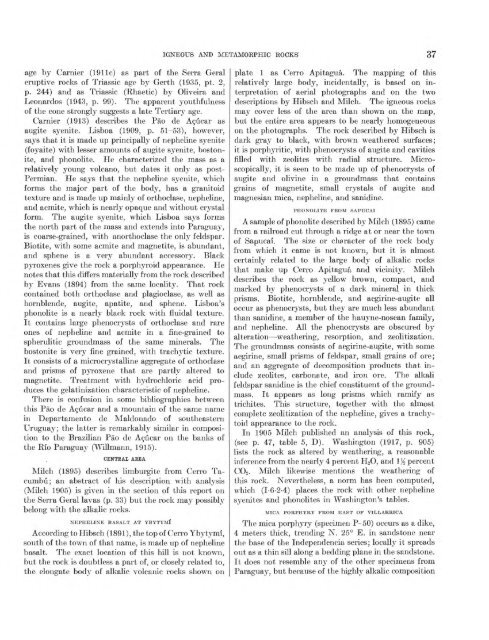Geology and Mineral Resources of Paraguay A Reconnaissance
Geology and Mineral Resources of Paraguay A Reconnaissance
Geology and Mineral Resources of Paraguay A Reconnaissance
- No tags were found...
Create successful ePaper yourself
Turn your PDF publications into a flip-book with our unique Google optimized e-Paper software.
IGNEOUS AND METAMORPHIC ROCKS' 37age by Carnier (191 Ic) as part <strong>of</strong> the Serra Geraleruptive rocks <strong>of</strong> Triassic age by Gerth (1935, pt. 2,p. 244) <strong>and</strong> as Triassic (Rhaetic) by Oliveira <strong>and</strong>Leonardos (1943, p. 99). The apparent youthfulness<strong>of</strong> the cone strongly suggests a late Tertiary age.Carnier (1913) describes the Pao de Acucar asaugite syenite. Lisboa (1909, p. 51-53), however,says that it is made up principally <strong>of</strong> nepheline syenite(foyaite) with lesser amounts <strong>of</strong> augite syenite, bostonite,<strong>and</strong> phonolite. He characterized the mass as arelatively young volcano, but dates it only as post-Permian. He says that the nepheline syenite, whichforms the major part <strong>of</strong> the body, has a granitoidtexture <strong>and</strong> is made up mainly <strong>of</strong> orthoclase, nepheline,<strong>and</strong> acmite, which is nearly opaque <strong>and</strong> without crystalform. The augite syenite, which Lisboa says formsthe north part <strong>of</strong> the mass <strong>and</strong> extends into <strong>Paraguay</strong>,is coarse-grained, with anorthoclase the only feldspar.Biotite, with some acmite <strong>and</strong> magnetite, is abundant,<strong>and</strong> sphene is a very abundant accessory. Blackpyroxenes give the rock a porphyroid appearance. Henotes that this differs materially from the rock describedby Evans (1894) from the same locality. That rockcontained both orthoclase <strong>and</strong> plagioclase, as well ashornblende, augite, apatite, <strong>and</strong> sphene. Lisboa'sphonolite is a nearly black rock with fluidal texture.It contains large phenocrysts <strong>of</strong> orthoclase <strong>and</strong> rareones <strong>of</strong> nepheline <strong>and</strong> acmite in a fine-grained tospherulitic groundmass <strong>of</strong> the same minerals. Thebostonite is very fine grained, with trachytic texture.It consists <strong>of</strong> a microcrystalline aggregate <strong>of</strong> orthoclase<strong>and</strong> prisms <strong>of</strong> pyroxene that are partly altered tomagnetite. Treatment with hydrochloric acid producesthe gelatinization characteristic <strong>of</strong> nepheline.There is confusion in some bibliographies betweenthis Pao de Agucar <strong>and</strong> a mountain <strong>of</strong> the same namein Departamento de Maldonado <strong>of</strong> southeasternUruguay; the latter is remarkably similar in compositionto the Brazilian Pao de Acucar on the banks <strong>of</strong>the Rio <strong>Paraguay</strong> (Willmann, 1915).CENTRAL AREAMilch (1895) describes limburgite from Cerro Tacumbu;an abstract <strong>of</strong> his description with analysis(Milch 1905) is given in the section <strong>of</strong> this report onthe Serra Geral lavas (p. 33) but the rock may possiblybelong with the alkalic rocks.NEPHELINE BASALT AT YBYTYMfAccording to Hibsch (1891), the top <strong>of</strong> Cerro Ybytymi,south <strong>of</strong> the town <strong>of</strong> that name, is made up <strong>of</strong> nephelinebasalt. The exact location <strong>of</strong> this hill is not known,but the rock is doubtless a part <strong>of</strong>, or closely related to,the elongate body <strong>of</strong> alkalic volcanic rocks shown onplate 1 as Cerro Apitagua. The mapping <strong>of</strong> thisrelatively large body, incidentally, is based on interpretation<strong>of</strong> aerial photographs <strong>and</strong> on the twodescriptions by Hibsch <strong>and</strong> Milch. The igneous rocksmay cover less <strong>of</strong> the area than shown on the map,but the entire area appears to be nearly homogeneouson the photographs. The rock described by Hibsch isdark gray to black, with brown weathered surfaces;it is porphyritic, with phenocrysts <strong>of</strong> augite <strong>and</strong> cavitiesfilled with zeolites with radial structure. Microscopically,it is seen to be made up <strong>of</strong> phenocrysts <strong>of</strong>augite <strong>and</strong> olivine in a groundmass that containsgrains <strong>of</strong> magnetite, small crystals <strong>of</strong> augite <strong>and</strong>magnesian mica, nepheline, <strong>and</strong> sanidine.PHONOLITE FROM SAPTJCAIA sample <strong>of</strong> phonolite described by Milch (1895) camefrom a railroad cut through a ridge at or near the town<strong>of</strong> Sapucai. The size or character <strong>of</strong> the rock bodyfrom which it came is not known, but it is almostcertainly related to the large body <strong>of</strong> alkalic rocksthat make up Cerro Apitagua <strong>and</strong> vicinity. Milchdescribes the rock as yellow brown, compact, <strong>and</strong>marked by phenocrysts <strong>of</strong> a dark mineral in thickprisms. Biotite, hornblende, <strong>and</strong> aegirine-augite alloccur as phenocrysts, but they are much less abundantthan sanidine, a member <strong>of</strong> the hauyne-nosean family,<strong>and</strong> nepheline. All the phenocrysts are obscured byalteration weathering, resorption, <strong>and</strong> zeolitization.The groundmass consists <strong>of</strong> aegirine-augite, with someaegirine, small prisms <strong>of</strong> feldspar, small grains <strong>of</strong> ore;<strong>and</strong> an aggregate <strong>of</strong> decomposition products that includezeolites, carbonate, <strong>and</strong> iron ore. The alkalifeldspar sanidine is the chief constituent <strong>of</strong> the groundmass.It appears as long prisms which ramify astrichites. This structure, together with the almostcomplete zeolitization <strong>of</strong> the nepheline, gives a trachytoidappearance to the rock.In 1905 Milch published an analysis <strong>of</strong> this rock,(see p. 47, table 5, D). Washington (1917, p. 905)lists the rock as altered by weathering, a reasonableinference from the nearly 4 percent H2O, <strong>and</strong> 1 % percentCO2 . Milch likewise mentions the weathering <strong>of</strong>this rock. Nevertheless, a norm has been computed,which (1-6-2-4) places the rock with other nephelinesyenites <strong>and</strong> phonolites in Washington's tables.MICA PORPHYRY FROM EAST OF VILLARRICAThe mica porphyry (specimen P- 50) occurs as a dike,4 meters thick, trending N. 25° E. in s<strong>and</strong>stone nearthe base <strong>of</strong> the Independencia series; locally it spreadsout as a thin sill along a bedding plane in the s<strong>and</strong>stone.It does not resemble any <strong>of</strong> the other specimens from<strong>Paraguay</strong>, but because <strong>of</strong> the highly alkalic composition
















